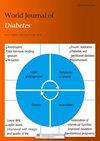恩格列净可能通过激活AMPK/PGC-1α和抑制RhoA/ROCK途径改善糖尿病心肌病变
IF 4.6
3区 医学
Q1 ENDOCRINOLOGY & METABOLISM
引用次数: 0
摘要
背景糖尿病心肌病(DCM)会增加糖尿病患者因心力衰竭(HF)住院和死亡的风险。然而,目前尚未发现可延缓 DCM 病程进展的特效疗法。线粒体功能障碍、氧化应激、炎症和钙处理失衡在DCM的病理过程中起着至关重要的作用,最终导致心肌细胞凋亡和心脏功能障碍。新型降糖药物 Empagliflozin 已被证实可降低糖尿病患者因心房颤动住院的风险。然而,这种药物提供心脏保护的分子机制仍不清楚。目的 探讨恩格列净对高血糖(HG)诱导的氧化应激和心肌细胞凋亡的影响及其分子机制。方法 分别采用 12 周大的 db/db 小鼠和新生大鼠的原代心肌细胞作为体内和体外模型。超声心动图用于评估心脏功能。流式细胞术和 TdT 介导的 dUTP 生物素缺口标记染色用于评估心肌细胞凋亡。线粒体功能通过细胞 ATP 水平和线粒体膜电位的变化进行评估。此外,还分析了细胞内活性氧的产生和超氧化物歧化酶的活性。实时定量 PCR 用于分析 Bax 和 Bcl-2 mRNA 的表达。Western 印迹分析用于测量 AMP 活化蛋白激酶(AMPK)和肌球蛋白磷酸酶靶亚基 1(MYPT1)的磷酸化,以及过氧化物酶体增殖激活受体-γ 辅激活因子-1α(PGC-1α)和活性 Caspase-3 蛋白水平。结果 在体内实验中,db/db 小鼠发生了 DCM。然而,用empagliflozin(10 mg/kg/d)治疗db/db小鼠8周后,心脏功能显著增强,心肌凋亡明显减少,同时心脏中AMPK磷酸化和PGC-1α蛋白水平增加,MYPT1磷酸化减少。在体外实验中,研究结果表明,用empagliflozin(10 μM)或fasudil(FA)(一种ROCK抑制剂,100 μM)或过表达PGC-1α处理心肌细胞可显著减轻HG诱导的线粒体损伤、氧化应激和心肌细胞凋亡。然而,加入化合物 C(CC)后,上述效应被部分逆转。在暴露于HG的细胞中,empagliflozin处理增加了p-AMPK和PGC-1α蛋白的水平,同时降低了磷酸化MYPT1的水平,这些变化在添加CC后得到缓解。在暴露于 HG 的细胞中添加 FA 和过表达 PGC-1α 可大幅提高 PGC-1α 蛋白水平。此外,在心肌细胞中未检测到钠-葡萄糖共转运体(SGLT)2 蛋白表达。结论 Empagliflozin 可通过激活 AMPK/PGC-1α 和抑制 RhoA/ROCK 通路(与 SGLT2 无关),在 HG 条件下对心肌细胞产生部分抗氧化应激和抗凋亡作用。本文章由计算机程序翻译,如有差异,请以英文原文为准。
Empagliflozin ameliorates diabetic cardiomyopathy probably via activating AMPK/PGC-1α and inhibiting the RhoA/ROCK pathway
BACKGROUND
Diabetic cardiomyopathy (DCM) increases the risk of hospitalization for heart failure (HF) and mortality in patients with diabetes mellitus. However, no specific therapy to delay the progression of DCM has been identified. Mitochondrial dysfunction, oxidative stress, inflammation, and calcium handling imbalance play a crucial role in the pathological processes of DCM, ultimately leading to cardiomyocyte apoptosis and cardiac dysfunctions. Empagliflozin, a novel glucose-lowering agent, has been confirmed to reduce the risk of hospitalization for HF in diabetic patients. Nevertheless, the molecular mechanisms by which this agent provides cardioprotection remain unclear.
AIM
To investigate the effects of empagliflozin on high glucose (HG)-induced oxidative stress and cardiomyocyte apoptosis and the underlying molecular mechanism.
METHODS
Twelve-week-old db/db mice and primary cardiomyocytes from neonatal rats stimulated with HG (30 mmol/L) were separately employed as in vivo and in vitro models. Echocardiography was used to evaluate cardiac function. Flow cytometry and TdT-mediated dUTP-biotin nick end labeling staining were used to assess apoptosis in myocardial cells. Mitochondrial function was assessed by cellular ATP levels and changes in mitochondrial membrane potential. Furthermore, intracellular reactive oxygen species production and superoxide dismutase activity were analyzed. Real-time quantitative PCR was used to analyze Bax and Bcl-2 mRNA expression. Western blot analysis was used to measure the phosphorylation of AMP-activated protein kinase (AMPK) and myosin phosphatase target subunit 1 (MYPT1), as well as the peroxisome proliferator-activated receptor-γ coactivator-1α (PGC-1α) and active caspase-3 protein levels.
RESULTS
In the in vivo experiment, db/db mice developed DCM. However, the treatment of db/db mice with empagliflozin (10 mg/kg/d) for 8 wk substantially enhanced cardiac function and significantly reduced myocardial apoptosis, accompanied by an increase in the phosphorylation of AMPK and PGC-1α protein levels, as well as a decrease in the phosphorylation of MYPT1 in the heart. In the in vitro experiment, the findings indicate that treatment of cardiomyocytes with empagliflozin (10 μM) or fasudil (FA) (a ROCK inhibitor, 100 μM) or overexpression of PGC-1α significantly attenuated HG-induced mitochondrial injury, oxidative stress, and cardiomyocyte apoptosis. However, the above effects were partly reversed by the addition of compound C (CC). In cells exposed to HG, empagliflozin treatment increased the protein levels of p-AMPK and PGC-1α protein while decreasing phosphorylated MYPT1 levels, and these changes were mitigated by the addition of CC. Adding FA and overexpressing PGC-1α in cells exposed to HG substantially increased PGC-1α protein levels. In addition, no sodium-glucose cotransporter (SGLT)2 protein expression was detected in cardiomyocytes.
CONCLUSION
Empagliflozin partially achieves anti-oxidative stress and anti-apoptotic effects on cardiomyocytes under HG conditions by activating AMPK/PGC-1α and suppressing of the RhoA/ROCK pathway independent of SGLT2.
求助全文
通过发布文献求助,成功后即可免费获取论文全文。
去求助
来源期刊

World Journal of Diabetes
ENDOCRINOLOGY & METABOLISM-
自引率
2.40%
发文量
909
期刊介绍:
The WJD is a high-quality, peer reviewed, open-access journal. The primary task of WJD is to rapidly publish high-quality original articles, reviews, editorials, and case reports in the field of diabetes. In order to promote productive academic communication, the peer review process for the WJD is transparent; to this end, all published manuscripts are accompanied by the anonymized reviewers’ comments as well as the authors’ responses. The primary aims of the WJD are to improve diagnostic, therapeutic and preventive modalities and the skills of clinicians and to guide clinical practice in diabetes. Scope: Diabetes Complications, Experimental Diabetes Mellitus, Type 1 Diabetes Mellitus, Type 2 Diabetes Mellitus, Diabetes, Gestational, Diabetic Angiopathies, Diabetic Cardiomyopathies, Diabetic Coma, Diabetic Ketoacidosis, Diabetic Nephropathies, Diabetic Neuropathies, Donohue Syndrome, Fetal Macrosomia, and Prediabetic State.
 求助内容:
求助内容: 应助结果提醒方式:
应助结果提醒方式:


